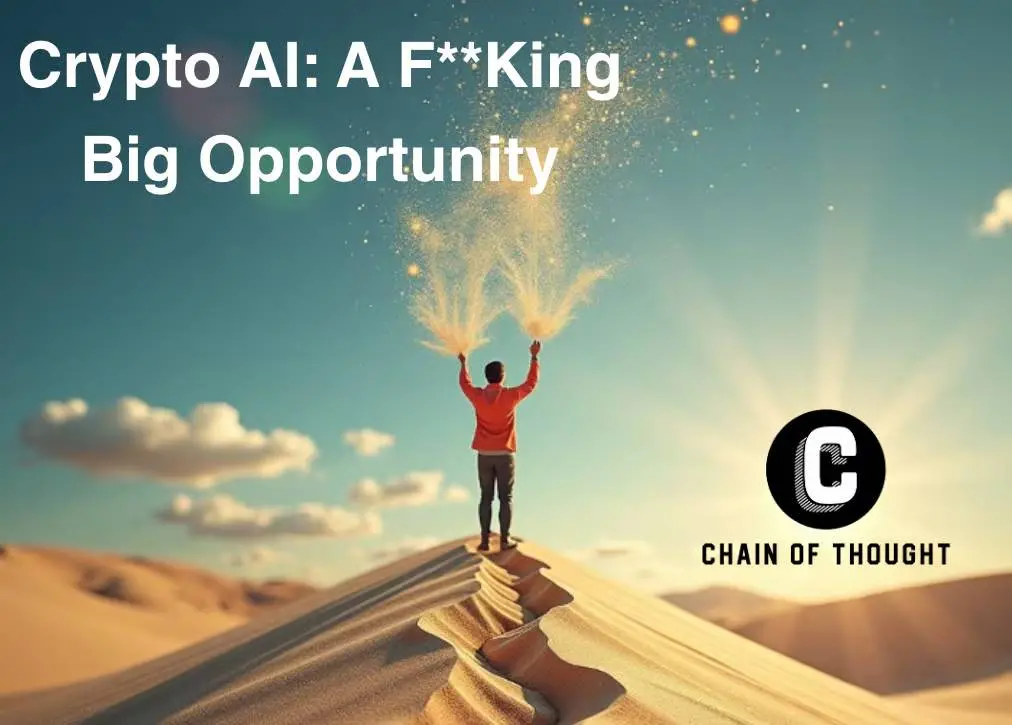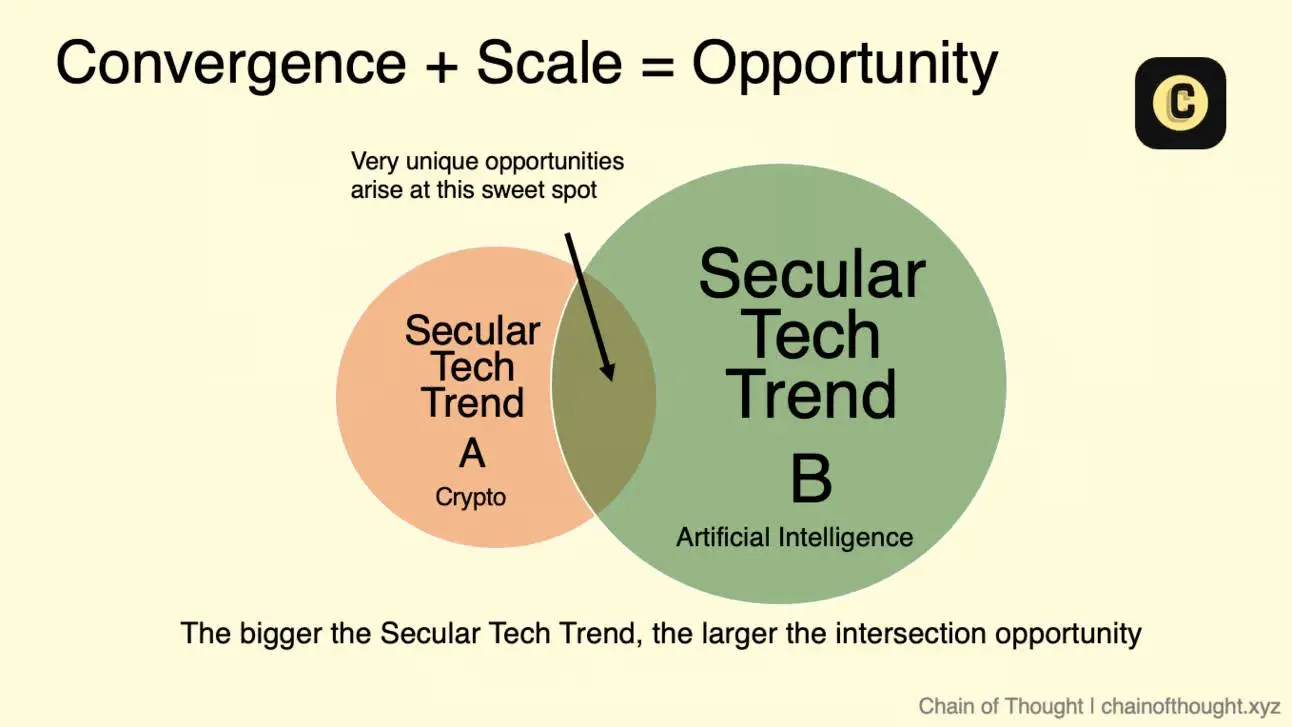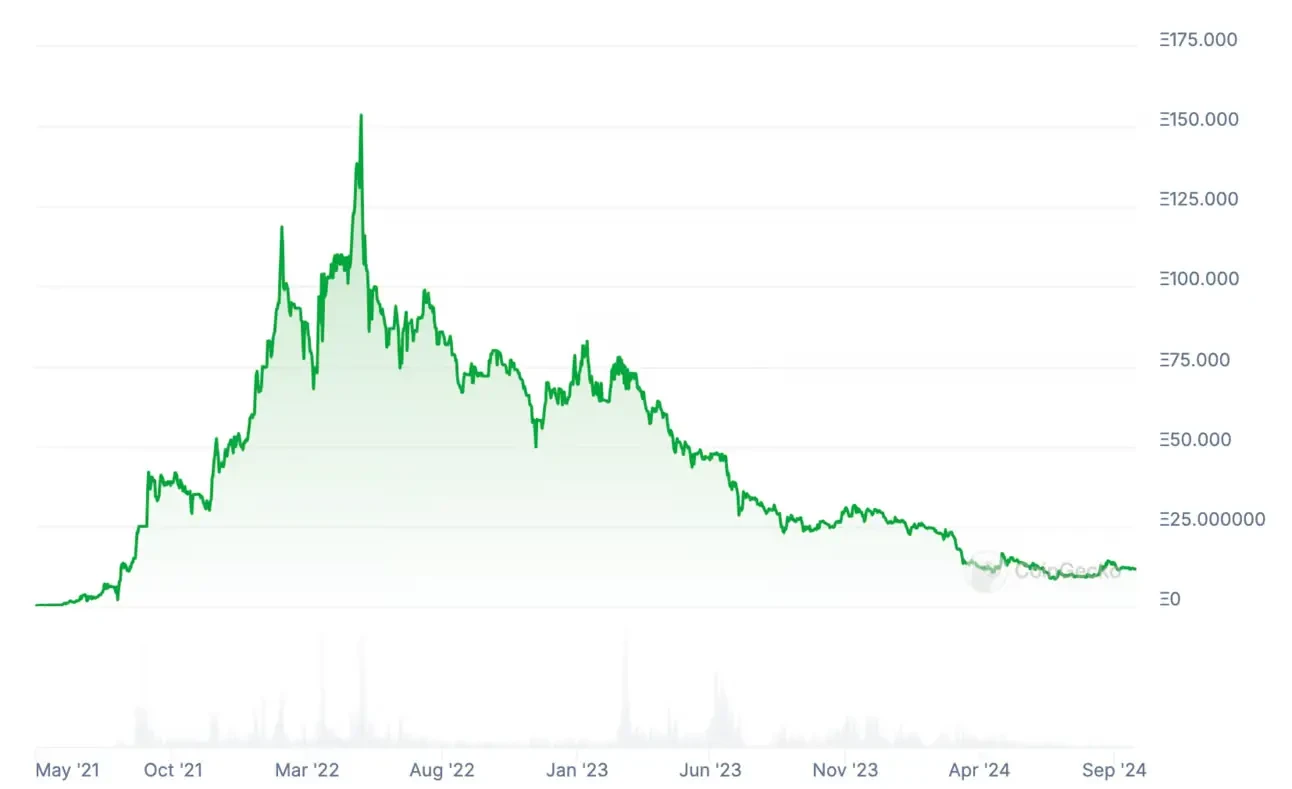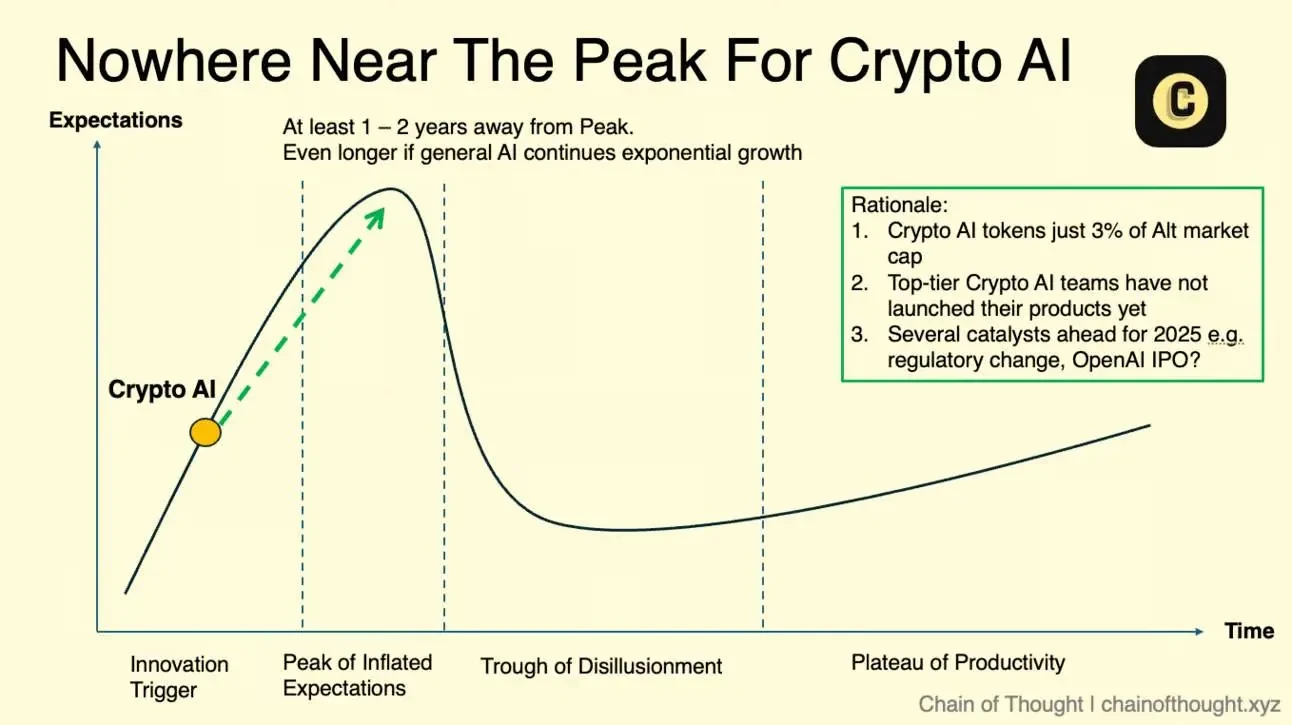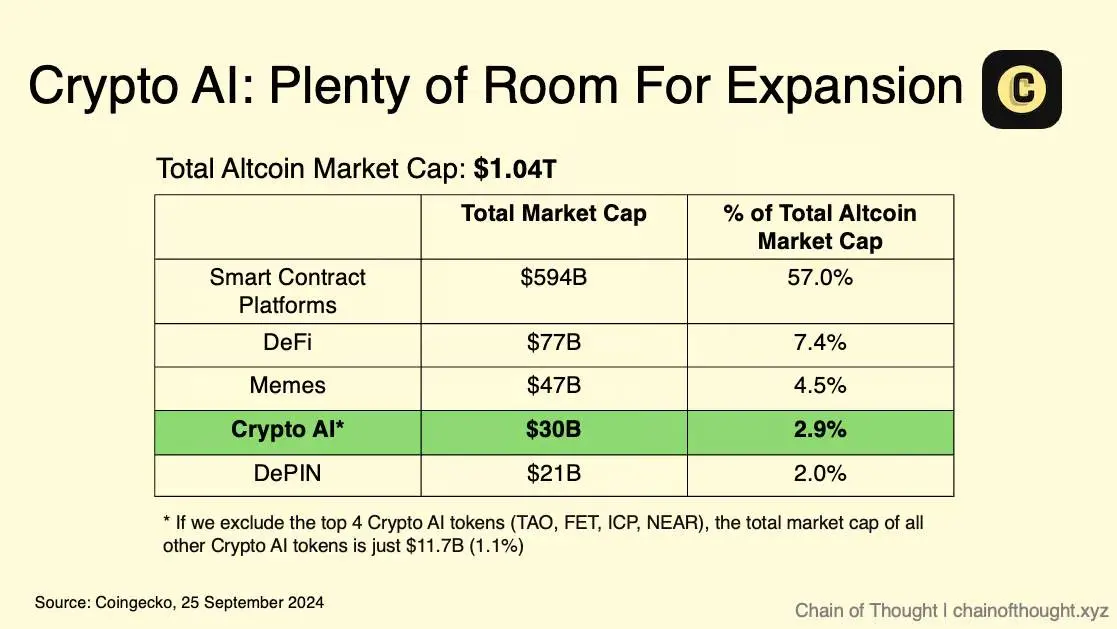Orijinal yazar: Teng Yan
Orijinal çeviri: TechFlow
Arkadaşlarıma sık sık şunu söylerim: 2022-2024 yıllarına baktığımızda, insan teknolojisinin önemli ölçüde hız kazandığı kritik bir dönem olduğunu göreceğiz.
Yapay zeka, ömrümüz boyunca karşılaşacağımız en dönüştürücü teknoloji trendi olabilir; ta ki ömrü yüzlerce yıl uzatacak bir mucize keşfedene kadar.
Bu, yapay zekanın şu anda çok popüler olduğu ve herkesin bu alanda yer almak istediği anlamına geliyor.
Sadece 2024'ün ilk yarısında, AI girişimleri $35 milyar yatırım çekti. Ve bu sadece özel sektör—yatırım, NVIDIA'dan büyük miktarda GPU satın alan ve NVIDIA'nın piyasa değerini şaşırtıcı bir şekilde $3 trilyona çıkaran Büyük Teknoloji içinde daha da büyük.
Ancak bu çılgınlığın ortasında, birçok kişi tarafından göz ardı edilen büyük bir potansiyel alanı var: kripto AI (veya merkezi olmayan AI).
2019 yılında bunu haber veren ileri görüşlü bir çizgi film vardı.
Tarih gösteriyor ki, her on yılda bir, pek olası görünmeyen, hatta aptalca görünen, ama sonuçta son derece vizyoner olduğu ortaya çıkan yatırım fırsatları karşımıza çıkıyor.
Sosyal medya bir zamanlar gerçek bir iş modeli olmayan gençler için sıkıcı bir eğlence olarak görülüyordu. Ancak Meta (eski adıyla Facebook) dünyanın en etkili şirketlerinden biri haline geldi ve erken yatırımcılar 1.000 kattan fazla getiri elde etti.
Kripto AI'nın hikayesi hem acil hem de ilgi çekici. Bunu insanlara açıkladığımda, çoğu kişi hemen anlıyor.
Yapay zekanın özü gücü yoğunlaştırmaktır. Kontrol altına alınmadığı takdirde, gücün kaçınılmaz olarak yapay zekayı kâr için kullanacak ve hakimiyet arayacak birkaç tekelci organizasyonun elinde yoğunlaşmasına yol açabilir. Bu nedenle, merkezi olmayan yapay zeka geleceğimiz için olmazsa olmazdır ve daha aydınlık, daha adil bir toplumun anahtarıdır. BEN sahip olmak Bu felsefi soruyu daha önce derinlemesine incelemiştik.
Ancak şüpheciler, kriptoyu yapay zekayla birleştirmenin sadece bir abartı olduğunu ve eğlence, oyun ve sosyal medya sektörlerinde kriptonun henüz kalıcı bir etki veya yaygın bir benimseme göstermediğini savunuyorlar. Hatta bu endişeyi bazı akıllı yatırımcılardan bile duydum ve bu geçerli bir endişe.
Ama bu sefer işlerin farklı olacağına inanıyorum.
CryptoAI'nin neden radikal olarak farklı bir yol izleyeceğine dair birkaç neden var. Bu makaleyi bu nedenleri ortaya koymak için yazdım.
İlk başta düşündüğümden daha çok konuşulacak şey var, bu yüzden yazıyı birkaç bölüme ayırmaya karar verdim.
Bu üç bölümlük sunumda, kripto AI için teknik ve yatırım manzarasına dalacağım. En umut verici alanları vurgulayacağım ve bu ortaya çıkan megatrendden yararlanmak için kendimi nasıl konumlandırdığımı göstereceğim.
Bölüm 1: Kripto AI Neden Odaklanılan Önemli Bir Alandır?
Bölüm II: Yapay zeka ajanları, merkezi olmayan eğitim, doğrulanabilir akıl yürütme, veri ağları (ve kripto yapay zekasının diğer alt alanları) hakkındaki düşüncelerim
Bölüm 3: Bu fırsattan değer elde etmenin birden fazla yolu
Dünya daha fazla yapay zekayla donatıldıkça, onu sınırlamak ve en değerli ve yeri doldurulamaz kaynağımız olan zaman için fiyatlandırma ve koruma sağlamak amacıyla daha fazla şifrelemeye ihtiyaç duyacağız. Preston Bryne
Teknolojik trendlerin kesiştiği noktada durmak
Bilgili yatırımcılar ve girişimciler olarak, her zaman değişimin dalgasını yakalamayı umuyoruz.
En büyük dalgaları yakalamak için, yerler nerede çoklu büyük eğilimler birleşiyor ve bunlardan faydalanın.
Bu, teknolojik gelişmelerin yönlendirdiği derin davranış değişikliklerine yol açan ve tüm endüstrileri yeniden tanımlama potansiyeline sahip olan uzun vadeli teknoloji trendlerini belirlemek anlamına gelir.
Kripto, parayı ele alış ve kullanma şeklimizi değiştiren böyle bir teknoloji trendidir. Diğer örnekler arasında bulut bilişim, mobil teknoloji ve temiz enerji yer alır.
Ancak, sadece bir teknoloji trendini takip etmek yeterli değil. Bu trendi görüp benzer yatırımlar yapan sayısız başkası var. Gerçekten öne çıkmak için, yüzeysel olarak belirgin olanın ötesine geçmemiz gerekiyor.
Bu yüzden lekelenme iki büyük teknoloji trendinin erken birleşmesi çok ilgi çekici.
İşte sihir burada gerçekleşiyor.
Yakınsama + Ölçek = Fırsat
(1) Entegrasyonun gücü
İki uzun vadeli eğilim bir araya geldiğinde, sıklıkla gözden kaçan yerlerde inovasyon ve değer için en iyi fırsatlar ortaya çıkar.
-
Çoklu Büyüme Sürücüleri: Birden fazla uzun vadeli trendin kesiştiği noktada bulunan şirketler, her bir trendin büyümesinden faydalanabilir.
-
Azalmış rekabet: Bu şirketler, birden fazla alanda derin uzmanlık gerektirmesi nedeniyle, giriş engellerinin yüksek olduğu pazarlarda benzersiz bir konum elde edebilmektedir.
-
Fikirlerin kesişimi: yenilikçi ürünlere ve iş modellerine yol açıyor.
(2) Ölçeğin gücü
Yatırımda pazar büyüklüğü çok önemlidir.
2000'lerin başındaki Amazon'u düşünün. Başarısı yalnızca e-ticaretten kaynaklanmıyordu, aynı zamanda ortaya çıkan bulut bilişim trendini yakalayıp Amazon Web Services'ı (AWS) yaratmasından da kaynaklanıyordu. AWS artık her yıl milyarlarca dolar gelir elde ediyor ve genişleyen bulut altyapısı pazarında lider konumda.
Uzun vadeli teknoloji trendleri, hem toplam hitap edilebilir pazar hem de büyüme potansiyeli açısından ne kadar büyükse, ne kadar erken girerseniz, kesişim noktalarında o kadar fazla fırsat olur.
Megatrendler yalnızca başarısızlığa karşı bir tampon sağlamakla kalmaz, aynı zamanda potansiyel ödülleri de büyük ölçüde artırır.
Kripto x AI
Uzun zamandır bilişimin omurgasını oluşturan CPU'lar ve GPU'lar, artık dünyanın süper bilgisayarı haline gelen ve insanlığın kolektif bilgeliğini ve yaratıcılığını harekete geçiren yapay zekaya güç veriyor.
Şifreleme teknolojisi, açık ve merkezi olmayan bir ağ oluşturmayı mümkün kılarak, gelecek nesil İnternet'in temellerini atıyor.
Bu süper bilgisayarlar ve süper ağlar bir araya geldiklerinde birbirlerini tamamlarlar.
-
Yapay zeka, kripto teknolojisinin kullanıcı deneyimini iyileştiriyor. Kullanıcılar cüzdanları, başlangıç ifadelerini ve imza işlemlerini nasıl yöneteceklerini öğrenmelerine gerek kalmadan, doğal dil aracılığıyla blok zinciriyle etkileşime girebilirler.
-
Kriptografi, yapay zekanın açıklığını ve sansüre dayanıklılığını garanti altına almak için güvene dayalı olmayan, izin gerektirmeyen ve güvenli bir altyapı sağlar. Ayrıca merkezi olmayan ağların kurulmasında güçlü bir koordinasyon katmanı olarak da görev yapar.
-
Bu birleşme, tamamen yeni iş modellerinin önünü açıyor.
Kripto ve yapay zekanın birleşimi, iki alan ayrı yollarda ilerledikçe katlanarak büyüyecek.
Anahtar, kriptografinin daha önce mümkün olmayan AI'yı etkinleştirmek için neler yapabileceğini bulmaktır — sır budur. İpucu: dağıtılmış eğitim, veri ağları ve özel veriler. Bunlar hakkında daha fazla bilgi için Bölüm 2'ye bakın.
Tarihten Ders Çıkarmak: NFT'ler ve DeFi İçin Bir Örnek
Bored Ape Yacht Club NFT'sinin rezerv fiyatı fırladı. Yuga Labs 2022'de $450 milyon fon topladı (veri kaynağı: Coingecko).
NFT'lerin yükselişi ve düşüşü bize önemli dersler sunuyor.
NFT'ler kripto topluluğunda sıcak bir konu olmuştur, ancak daha fazla gelişmek için başka bir uzun vadeli teknoloji trendinin desteğinden yoksundurlar. Eğlence ve oyun - NFT'lerin ana uygulama alanları - güçlü geleneksel şirketlerin hakim olduğu karmaşık ve olgun pazarlardır ve geliştirme ivmeleri yalnızca teknolojiye bağlı değildir.
Sonuç olarak, NFT'ler erken büyüme ivmelerini korumayı başaramadı. Kullanım durumları gerçek olsa da, potansiyellerini gerçekleştirmeleri daha uzun sürecek.
Buna karşılık DeFi, uzun vadeli teknoloji trendlerinin kesiştiği noktanın başarılı bir örneğidir.
DeFi, fintech ve kriptografiyi birleştirerek, geleneksel bankacılık, kredi ve varlık yönetimine alternatifler sunarak ve gerçek dünyadaki finansal ihtiyaçları karşılayarak finansal hizmetlerde devrim yarattı. Şu anda, stablecoin'lerin toplam piyasa değeri tüm zamanların en yüksek seviyesine ($170 milyar) ulaştı ve büyümeye devam ederken, $82 milyar DeFi protokollerinde kilitli.
Jeton: Açık kaynaklı yapay zekanın şifreleme teknolojisine ihtiyacı var
Büyük teknoloji şirketlerinin büyük dil modellerinin kapalı yapısı, AI demokrasisinin gerçekleşmesini engellemiştir. Her geliştirici veya kullanıcı, büyük dil modellerine algoritmalar ve veriler katkıda bulunabilmeli ve modellerin gelecekteki faydalarından pay alabilmelidir. AI erişilebilir, alakalı ve herkes tarafından sahiplenilmelidir. —— Catrina Wang (Portal Girişimleri)
İnsanlar bana yapay zekanın neden kriptografiye ihtiyacı olduğunu sorduğunda cevabım basit: Token'lar.
Geleneksel yazılım neredeyse hiçbir maliyet olmadan genişletilebilir. Kod yazıldıktan sonra her yere dağıtılabilir.
Ancak yapay zeka tamamen farklı. Yüksek sermaye ve marjinal maliyet gerektirir.
Büyük ölçekli yapay zeka modellerinin eğitilmesi ve dağıtılması, büyük miktarda bilgi işlem kaynağı gerektirir; bu da verimlilik ve altyapı erişilebilirliğini başarının kritik faktörleri haline getirir.
Şu anda, OpenAI, Anthropic ve Google gibi merkezi devlerin egemen olduğu bir dünyada yaşıyoruz. Bu şirketlerin bol miktarda yeteneği, donanımı ve sermayesi var. Ancak dürüst olalım: kurumsal sahipli AI her zaman kârı maksimize etme hedefi tarafından yönlendirilir.
Meta'nın açık kaynaklı AI'ya katkısı paha biçilmez olsa da, Llama 3 gibi son teknoloji modelleri yayınlamayı bırakmayacaklarını kim söyleyebilir? Bu sistemlerin geliştirilmesi yüz milyonlarca dolara mal oldu ve Zuck bir gün sinirlenirse, proje durdurulabilir.
Açık kaynak hareketinin bu devlerle sadece idealler veya iyi niyetler temelinde rekabet etmesini beklemek açıkçası gerçekçi değil. Yeni bir stratejiye ihtiyacımız var.
Aslında, en iyi AI araştırma laboratuvarları dışında açık kaynak dünyasında çok miktarda yeterince kullanılmayan bilgi işlem kaynağı, araştırma ve yetenek bulunmaktadır. Bunlara üniversiteler, araştırma merkezleri, Hugging Face gibi iş birliği platformları ve bireysel AI araştırmacılarının katkıları dahildir. Ancak, şu anda bu kaynaklar parçalanmış durumdadır ve büyük ölçekli atılımlar elde etmek için gerekli koordinasyondan yoksundur.
İşte tam bu noktada Token'lar devreye giriyor.
Gibi @uzun_yalnızlık Zee Prime'da yazılanlara göre, token'lar kripto paraların en güçlü özelliğini temsil ediyor: izinsiz sermaye oluşumu.
Token'lar geleneksel finansman modellerinin yapamadığı şeyleri başarabilir:
-
Geleneksel risk sermayesi modeli altında asla gün yüzü göremeyecek deneysel yapay zeka projeleri için aşağıdan yukarıya finansman fırsatları sağlarlar.
-
Merkezi olmayan ağları başlatabilir ve katkıda bulunanlara mülkiyet ve değer dağıtarak bunları gelişen ve kendi kendini idame ettiren ekosistemlere dönüştürebilirler. Bittensor erken bir kavram kanıtı örneğidir.
-
Örneğin, yapay zeka girişimlerinin karşılaştığı büyük ön altyapı maliyetlerini ağın kendisine kaydırarak veya GPU aracılığıyla dünyanın dört bir yanındaki evlerdeki boştaki GPU kaynaklarını değerlendirerek maliyetleri önemli ölçüde azaltan DePIN tarzı token ekonomisi aracılığıyla tamamen yeni iş modelleri yaratıyorlar. Pazar yeri hesaplama birimi başına maliyeti düşürmek.
Token'lar, sıradan yatırımcılara, çoğu zaman hafife alınan AI dalgasına katılmak için büyük bir fırsat sunuyor.
Kripto para şu konularda iyidir: İnsanların ticaret yapmaya istekli olduğu yeni pazarlar bulmak. NFT'lere ve kültürel varlıklara, yaratıcı ekonomi için sosyal token'lara ve viral memecoin'lere bakın.
İnanıyorum ki Erken aşama yapay zeka projelerine sıradan yatırımcıların katılım talebi çok büyük ve henüz tam olarak karşılanmadı.
Yapay zeka günlük hayatlarımıza daha derinden entegre oldukça ve daha önce yapamadığımız şeyleri yapmamızı sağladıkça, insanlar onun ölçeğini ve gerçek dünyadaki etkilerini fark etmeye başlıyor. Çok fazla spekülasyon olacak olsa da, bu aynı zamanda herkesin hayatlarımızın en büyük teknolojik devrimine katılmasını sağlamakla ve herkese bir sonraki büyük fırsatı yakalama şansı vermekle ilgilidir.
Gelecekte daha şaşırtıcı gelişmelere hazır olun.
Peki, neden şimdi?
Kaynak: Syncracy Capital
Yeni teknolojiler genellikle belirgin bir yenilik döngüsünü takip eder.
En bilinen çerçevelerden biri, yeniliklerin nasıl abartı aşamasından geçtiğini, hayal kırıklığı çukuruna düştüğünü ve sonunda gerçek dünyada benimsendiğini tasvir eden Gartner Hype Cycle'dır.
Yatırımcılar için yatırım yapmak için ideal zaman, ya yeni inovasyonun tetikleyici noktasını fark ettiğinizde, yani abartının zirvesindeyken ya da hayal kırıklığının dibinde, yani olgunlaşmak üzere olan girişimleri tespit edebildiğinizdedir.
Peki, milyon dolarlık soru geliyor: Kripto Yapay Zeka'nın inovasyon döngüsünde neredeyiz?
Mevcut fikir birliğini göstermek için Syncracy Capital'den gelen bu grafiği kullanmak istiyorum.
Grafik, merkezi olmayan AI'nın beklentilerin zirvesine yaklaştığını veya ulaştığını gösteriyor. Kripto AI, birden fazla protokolün milyarlarca dolarlık değerlemelere ulaşmasıyla güçlü bir yıl geçirdi.
Ama ben bu görüşe katılmıyorum. Kripto AI'nın zirvesinin henüz çok uzakta olduğunu düşünüyorum.
Mevcut fikir birliği, bu alanın gelecekteki muazzam potansiyelini küçümsüyor. Henüz çılgınlık aşamasına bile girmedik. Etrafınızdaki insanlara sorun, kaç kişi Bittensor'u gerçekten Kripto AI'nın bir göstergesi olarak anlıyor? Aslında, gerçek zirveyi görmenin 1 ila 2 yıl daha sürebileceğine inanıyorum.
İşte nedenleri:
1. Crypto AI tokeninin toplam piyasa değeri $30 milyardır ve tüm altcoin'lerin toplam piyasa değerinin yalnızca 2,9%'sini (US$1,04 trilyon) oluşturmaktadır.
Günümüzde sadece dört büyük Kripto AI protokolü bulunmaktadır: TAO, NEAR, FET ve ICP. Bu protokollerin piyasa değerleri ise $5 milyar ile $10 milyar arasında değişmektedir.
Bu dördünü hariç tutarak ve ICP ve NEAR'ın özel Crypto AI token'ları olmadığını düşünürsek, Crypto AI'nın toplam piyasa değeri sadece $11.7 milyardır. Bu, Memecoin'in piyasa değerinin 25%'sinden daha azdır.
Ayrıca, yalnızca dört Crypto AI projesinin (RENDER, GRT, AKT, AIOZ) değeri $500 milyon ABD doları ile $5 milyar ABD doları arasında olup, projelerin çoğunun piyasa değeri $100 milyon ABD doları ile $200 milyon ABD doları arasında değildir.
Bu piyasa değeri, trendlerin bu şekilde bir araya gelmesinin muazzam potansiyeli düşünüldüğünde önemsizdir. Kripto AI, AI için tasarlanmış yeni nesil akıllı sözleşme platformları da dahil olmak üzere hem altyapıyı hem de uygulamaları kapsar.
Karşılaştırıldığında, akıllı sözleşme platformlarının toplam piyasa değeri şu anda $600 milyara yakın. $10 milyardan fazla piyasa değerine sahip 8 Katman 1 protokolü ve $1 milyar ile $10 milyar arasında 12 protokol bulunmaktadır.
Kripto Yapay Zeka pazarı ne kadar büyük olabilir? Henüz erken bir aşamadayız ve kimse kesin bir tahminde bulunamıyor.
Buna göre Bloomberg İstihbaratı , üretken AI pazarının 2032 yılına kadar yıllık ortalama 30%'den fazla büyüme oranıyla genişleyerek $1,3 trilyona ulaşması bekleniyor. Merkezi olmayan AI, tüm AI pazarının 10%'sini ele geçirebilirse ve kripto pazarında yaygın olan 3x spekülatif primi hesaba katarsak, bu, pazar büyüklüğünün 2032 yılına kadar $390 milyara ulaşacağı anlamına gelir - mevcut $30 milyardan 13 kat artış.
Sezgisel olarak bu tahminin çok muhafazakar olduğunu ve zaman aralığının pratik bir referans olarak kullanılamayacak kadar uzun olduğunu düşünüyorum.
Buna bakmanın bir başka yolu da önümüzdeki 3 yıl içinde (2027'ye kadar), AI uygulamaları ve akıllı sözleşme platformları piyasaya sürülüp ivme kazandıkça, Crypto AI'nın altcoin piyasasının toplam piyasa değerinin 10%'sini oluşturacağını varsaymaktır. Altcoin piyasa değeri o zamana kadar $2,7 trilyona ulaşırsa (2021'deki $1,8 trilyon zirvesinden 50% artış), Crypto AI'nın piyasa değeri $270 milyara ulaşacaktır - mevcut artışın yaklaşık 9 katı. Bu, piyasaya sürülmeyi bekleyen $240 milyar potansiyel değer olduğu anlamına gelir.
Ancak bu sayılar kesin tahminlerden daha çok açıklayıcıdır, çünkü çok fazla değişken vardır. Ancak, fırsatın genişliğini gösterirler ve değerlemeyi düşündüğümüzde mantıklı bir referans sağlarlar.
2. En iyi Kripto AI ekipleri henüz başlıyor
Birçok üst düzey ekip 1-2 yıldır araştırma ve geliştirme yapıyor ve henüz ürünlerini ana ağa bile çıkarmadılar.
Bu takımlardan bazıları, Sentient, Sahara, Vana, Story Protocol, Gensyn, Space and Time, Ritual, Nillion vb. dahil olmak üzere onlarca milyon dolarlık risk sermayesi aldı. Önümüzdeki 12 ayda, büyük ana ağların lansmanını ve token'ların çıkarılmasını göreceğiz - örneğin, AO Bilgisayar Ekosistem, bu yılın başlarında bahsettiğim, dikkat edilmesi gereken bir proje.
3. Yapay zeka hızla gelişiyor
Örneğin, OpenAI'nin yakın zamanda başlattığı o1 modeli, akıl yürütme yeteneklerinde önemli ilerleme kaydetti. Ölçekleme yasası hala geçerli ve Crypto AI, daha geniş AI büyüme trendini yakından takip edecek.
Bununla birlikte, piyasada şu anda çok fazla gürültü var, belki de kripto paranın diğer alanlarından daha fazla ve birçok girişim ve protokol, kısa vadede başarı elde etseler bile kaçınılmaz olarak başarısız olacaklar.
Bu nedenle, geniş bir ağ atan bir stratejiden ziyade, potansiyel kazananları seçici bir şekilde belirlemek daha etkili olabilir.
2025 İçin Pozitif Katalizörler
Önümüzdeki yıl Crypto AI'nın sektörün gelişimini ve ilgili piyasa beklentilerini yönlendirecek birçok olumlu faktörü beraberinde getireceğini bekliyorum.
-
Geleneksel teknoloji VC fonları Kripto AI'ya giriyor: a16z zaten dahil olsa da, Sequoia, Lightspeed ve Accel gibi büyük yatırımcılar henüz suya ayaklarını soktular. Merkezi olmayan AI'ya yatırımlarını kademeli olarak artırdıkça, alana daha fazla fon ve meşruiyet getirecekler.
-
OpenAI halka arzı : OpenAI'nin $150 milyarlık özel bir değerlemesi var ve geliri büyümeye devam ediyor. 2025'te ilk halka arz (IPO) yapılırsa, perakende yatırımcıların AI yatırımına olan hevesini artırabilir. NVIDIA ve donanım sektörünün dışında, perakende yatırımcıların AI trendinden doğrudan kar elde etmek için çok az fırsatı var. Bu talep birikimi, Coinbase gibi platformlarda kolayca elde edilebilen Crypto AI Token'larına kayabilir.
-
Daha dost canlısı bir ABD hükümeti: ABD hükümeti Kasım 2024 seçimlerinden sonra kripto token'lara karşı daha dostça bir politika benimserse, bu durum Kripto Yapay Zeka sektörüne büyük bir destek sağlayacak, daha net bir düzenleyici ortam sağlayacak ve daha geniş bir benimsenmeyi teşvik edecektir.
-
Yapay Zekada Atılımlar: Yapay zeka teknolojisinin hızlı gelişimi yavaşlama belirtisi göstermiyor. Sam Altman, yakın zamanda yazdığı bir blog yazısında, yapay zeka teknolojisine yönelik vizyonunu şöyle açıklıyor: parlak Yapay Zeka için gelecek. Yapay Zeka ajanlarındaki ve dağıtılmış Yapay Zeka eğitimindeki gelişmeler yeni kullanım durumlarının kilidini açacak ve daha fazla ilerlemeyi teşvik edecektir.
Kripto AI'nın Risk Faktörleri
Crypto AI'nın muazzam potansiyeli konusunda iyimser olsam da, hiçbir şeyin kesinlikle kesin olmadığını da biliyorum. Aşağıdaki risk faktörleri gerçekleşirse fikrim değişebilir:
-
Olumsuz düzenleyici ortam: Amerika Birleşik Devletleri gibi büyük pazarlarda, kripto düzenleyici ortamı elverişsizse, inovasyonu engelleyebilir, sermaye girişlerini sınırlayabilir ve kripto projelerini gri bir alana itebilir. Token'lar, merkezi olmayan ağların çekirdeğidir ve katı kısıtlamalar kriptonun temel değer sürücülerini zayıflatacaktır. Trump seçilirse bunun gerçekleşme olasılığı daha düşük, ancak Kamala başkan olursa bunun gerçekleşme olasılığı daha yüksektir.
-
Yapay zeka vaadini yerine getiremiyor: Mevcut piyasa coşkusuna ve milyarlarca dolarlık yatırıma rağmen, AI vaadini yerine getiremeyebilir. İlerleme yavaşlarsa veya engellerle karşılaşırsa, AI balonu patlayabilir. Bence bu senaryo pek olası değil.
-
Büyük bir pazar ve ürün-pazar uyumunun (PMF) bulunamaması: Ne kadar yenilikçi olursa olsun, Crypto AI projeleri uygulanabilir bir iş modeli ve ürün-pazar uyumu bulmalıdır. Merkezi olmayan AI anlamlı iş uygulamalarını entegre etmekte başarısız olursa, sektör durgunlaşabilir. Bu durumda, Crypto AI bir niş alan haline gelebilir.
-
Yetenek sıkıntısı: Sınırlı sayıda üst düzey makine öğrenimi bilim insanı ve mühendisi var. Crypto AI, açık, demokratikleştirilmiş bir AI geleceği vizyonuna inanan yeterli sayıda üst düzey yeteneği çekemezse, inovasyon yavaşlayacak ve sektör rekabetçi kalmakta zorlanacaktır.
Çözüm
İronik olarak, yapay zeka kripto dünyasının bugüne kadarki en büyük fırsatı olabilir.
Oyunların, NFT'lerin ve sosyal uygulamaların başaramadığı bir şey olan, gerçek ana akım benimsenmesinin ve gerçek dünya kullanım durumlarının önünü açıyor.
Açık ve kamusal ağlar tarafından desteklenen merkezi olmayan bir AI geleceğine doğru ilerliyoruz. En ileri görüşlü kurucular ve yatırımcılar bunu fark etti.
Kripto AI alanındaki en büyük zorluk, yalnızca kripto alanına odaklanamamanızdır, aksi takdirde gelecekteki gelişmeler hakkında çok dar ve yüzeysel bir anlayışa sahip olursunuz. Makine öğrenimindeki en son gelişmeleri takip etmeniz, en son Arxiv makalelerini incelemeniz ve AI'da bir sonraki büyük atılımı yarattıklarına inanan kurucularla iletişim kurmanız gerekir.
Dürüst olmak gerekirse, hiç bu kadar heyecanlanmamıştım.
Bu yazı internetten alınmıştır: Zirveye daha çok var, Crypto x AI'nın potansiyeli ne kadar?
Story Protocol'ün ilk çekirdek katılımcısı olan PIP Labs, a16z kripto para biriminin öncülüğünde ve Polychain tarafından stratejik olarak yatırım yapılan $80 milyonluk Seri B finansmanının tamamlandığını duyurdu. Diğer tanınmış yatırımcılar arasında Stability AI'nın kıdemli başkan yardımcısı ve yönetim kurulu üyesi Scott Trowbridge, K11'in kurucusu Adrian Cheng ve dijital sanat koleksiyoncusu Cozomo de Medici yer alıyor. Bu finansman turu, PIP Labs'ın toplam finansmanını $140 milyona çıkarıyor. Fikri mülkiyet (FM), yalnızca Hollywood filmleri ve Billboard grafikleri değil, aynı zamanda eğitim verileri, AI modelleri, memler, UGC videoları, oyun varlıkları, karakter özellikleri vb. de dahil olmak üzere dünyanın en büyük varlık sınıflarından biridir. Yapay zekanın yükselişiyle birlikte, FM, büyük ölçekli model eğitimi için temel girdi olarak daha değerli hale geliyor. Kısacası, FM olmadan, Yapay Zekanın gelişimi bir darboğaza girebilir. Ancak,…
